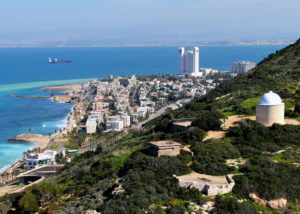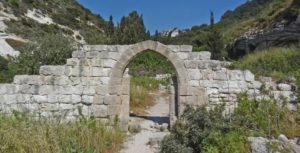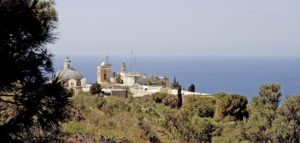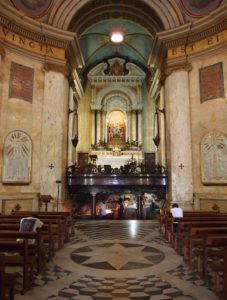Mount Carmel, being the only promontory on the coast, is the first visual contact with the Holy Land for anyone arriving by sea.

The oratory of the Holy Family (formerly a mill), the modern city of Haifa, and the bay of Haifa (Wikimedia Commons).
The books of the Old Testament mention Mount Carmel several times, always emphasizing its prominent position or fertility. In the Song of Songs, it is likened to a mountain crowning the head of the Beloved (7:6). Isaiah (33:9) prophesies a drought that will cause the leaves of the trees to fall, even in the fertile lands of Bashan and Carmel (see also Jeremiah 50:19; Amos 1:2, and Nahum 1:4). The “splendor of Carmel” is also mentioned in Isaiah (35:2) along with the “glory of Lebanon.”
But the most significant biblical memory associated with Mount Carmel concerns the prophet Elijah. On the mountaintop, Elijah challenged the priests of Baal (1 Kings 18). In the northwest of the Carmel range, a monastery of the Carmelite Order stands on a place called Al-Muhraqa in Arabic, to commemorate the event.
More than just a mountain range, Mount Carmel is a triangular-shaped massif slightly inclined to the south. On its western part, bordering the sea, Carmel is traversed by several deep torrents. In the 12th century, some hermits, inspired by the reclusive life of the prophet Elijah, chose one of these torrents – Wadi Siah – as a place of retreat. They dug their cells into the soft chalk of the mountain slope and built a chapel dedicated to Our Lady of Mount Carmel. Suddenly, the tranquility of this monastic community was disrupted when on July 4, 1187, Sultan Saladin defeated the army of the King of Jerusalem in the Battle of Hattin, above Tiberias. The Muslim armies spread throughout the country and conquered almost the entire Crusader Kingdom of Jerusalem in a few weeks. The hermits were expelled, and with them, the incipient Carmelite Order. The Order was later reestablished in Europe with great difficulties.

Ruins of the medieval convent in Wadi Siah (Carmel Holy Land)
In the final decades of the 12th century, the Church witnessed an unprecedented flourishing of religious orders. To bring order to so much founding activity, the Fourth Lateran Council (1215) established that foundations created after the council had to integrate into other already established orders. The existence of the Carmelite Order was at risk since its statutes had not been approved at that time. It is in this context that the Virgin Mary appeared to the Carmelite general, Saint Simon Stock, assuring him that the Order enjoyed divine favor. As a sign of this divine protection, the Virgin gave Saint Simon the “brown scapular.”
It was not until the Modern Age and the refoundation of the Carmelite Order by Saint Teresa of Avila and Saint John of the Cross that the devotion to the Carmelite scapular took root and spread throughout the Catholic world. As a sign of this spiritual renewal, a Carmelite convent was founded on the western peak of Mount Carmel. The new building, called Stella Maris, held dominion over the sea: pilgrims usually stood on the decks of their ships, praying a Hail Holy Queen as they beheld it.

Stella Maris Convent (Carmel Holy Land)
In 1799, General Napoleon Bonaparte and his army failed in their attempt to conquer the walls of Acre. In their retreat, Napoleon left about fifteen soldiers infected with the plague at the Stella Maris monastery. They were killed by the Ottoman army after their victory over the French. A pyramid-shaped monument – in reference to the French general’s campaign in Egypt – welcomes visitors in front of the monastery facade. The engraving, inspired by David’s lament after the death of King Saul and his son Jonathan, reads in Latin: “Quomodo ceciderunt fortes in bello / How have the mighty fallen in the midst of the battle?” (2 Samuel 1:25).
Destroyed by Abdullah Pasha, the governor of Acre, in 1821, the monastery was rebuilt in its current form in 1836.
Upon entering the church, the pilgrim encounters a beautiful carving of Our Lady of Mount Carmel behind the main altar, above a gallery. Below that, a staircase leads to the cave of the prophet Elijah, for whom the Galilean inhabitants hold great devotion.
By Henri Gourinard

Interior of Stella Maris Church (Wikimedia Commons).
